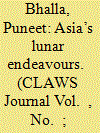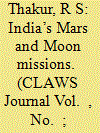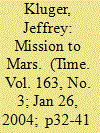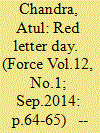| Srl | Item |
| 1 |
ID:
139176


|
|
|
|
|
| Summary/Abstract |
Interest in the exploration of the Moon, much like its phases, has waxed and waned since the beginning of space exploration. The quest for the Moon was an integral part of the space race between the Soviets and the Americans in the 1960s and 1970s, which resulted in a total of 65 missions, including the six manned missions by the US, before they both shifted focus to manned space stations and missions to Mars. Strategically or militarily, the Moon did not offer them much advantage. Scientifically, there was not much that was expected to be revealed after the first few missions. Economically, there was no great rationale for continuing a high cost programme from which few commercial gains could be expected at the time. Mars offered more opportunities for national prestige, scientific discovery as well as mining prospects. In the next few decades, although there were periodic statements about the potential of lunar exploration, these did not translate into actual efforts by any space-faring nation.
|
|
|
|
|
|
|
|
|
|
|
|
|
|
|
|
| 2 |
ID:
139177


|
|
|
|
|
| Summary/Abstract |
The Moon and Mars have stirred the imagination of space scientists since ages because of their relative proximity to Earth, as compared with other heavenly bodies. The Moon, located at a distance of 38,000 km, is the heavenly body nearest to the Earth. It is natural that our satellite remained the object of the first research since the beginning of the Space Age. Mars, the fourth planet in the solar system after Earth, has a year of 687 days and a day which differs from the Earth-day by a little less than half an hour; it is smaller as well as lighter than the Earth and less dense too with its gravity just about 38 percent of the gravity on Earth. It has two satellites: Phobos and Deimos. Soon after the dawn of the Space Age in 1957, both the US and erstwhile USSR initiated numerous projects to carry out wide-sweeping reconnaissance of the solar system, including the Moon and Mars, during the 1960s and 1970s. This was followed by increasing European and Japanese activities in the area of interplanetary exploration in 1980.1 Since then, there has been an overall continuity in nations attempting interplanetary exploration. India, with its robust space programme, has been making steady progress in deep space exploration, along with other space-faring nations right from the beginning.
|
|
|
|
|
|
|
|
|
|
|
|
|
|
|
|
| 3 |
ID:
049721


|
|
|
| 4 |
ID:
133501


|
|
|
|
|
| Publication |
2014.
|
| Summary/Abstract |
The Indian Space Research Organisation's (ISRO) Mars Orbiter Mission (MOM) spacecraft concludes its incredible 680 million km journey this month, which began when the Mars Obiter was launched from the Satish Dhawan Space Centre (SHAR) at Sriharikota in November last year.
In a post on its Facebook page, in the last week of August, ISRO announced that its Mars Orbiter Mission spacecraft was just 9 million km away from Mars. ISRO scientists have already begun preparations for the moment of truth for the mission; when the spacecraft is released into Mars Orbit.
|
|
|
|
|
|
|
|
|
|
|
|
|
|
|
|